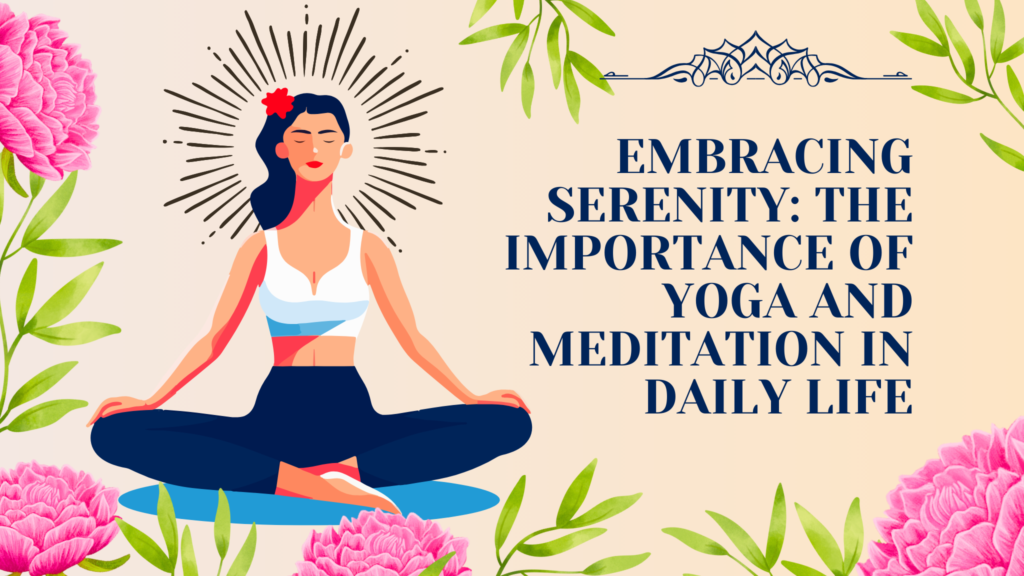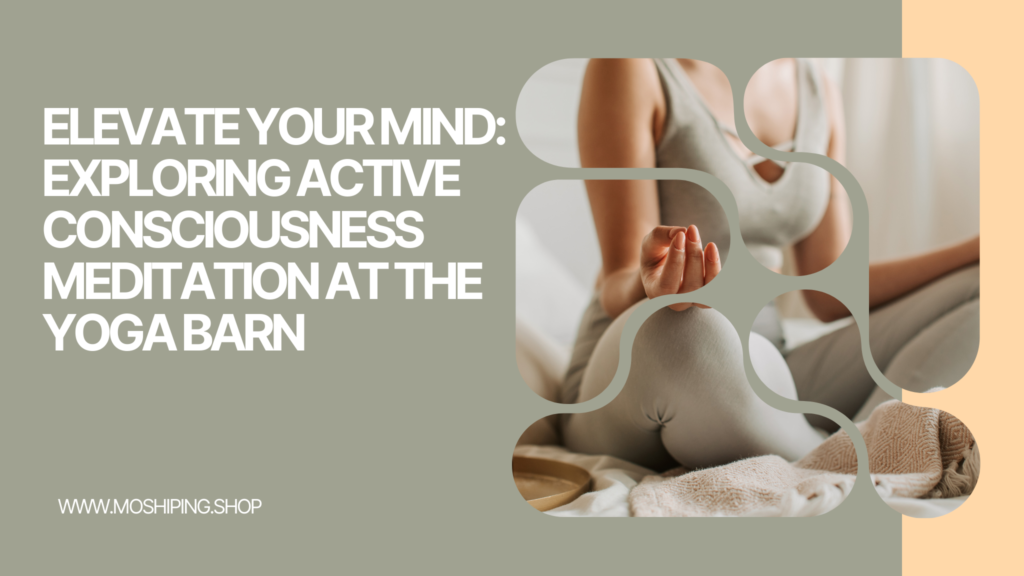In today’s fast-paced world, finding of tranquility can be a challenge. Yoga and meditation offer an accessible and effective way to cultivate peace, balance, and well-being in daily life. This article delves into the profound importance of integrating yoga and meditation into your routine and explores the multifaceted benefits these practices bring.
The Mental Wellness Boost
Enhancing Emotional Resilience
Yoga and meditation are effective tools for managing stress and enhancing emotional resilience. The practice encourages mindfulness—a state of being present and fully engaged with whatever you’re doing at the moment.
- Psychological Benefits:
- Stress Reduction: Meditation techniques like mindfulness and deep breathing help calm the sympathetic nervous system, reducing stress hormones like cortisol.
- Emotional Balance: Regular practice fosters a balanced emotional state by promoting a positive outlook and reducing feelings of anxiety and depression.
Example: Incorporating just 10 minutes of meditation into your morning routine can set a positive tone for the rest of the day. Apps like Headspace or Calm offer guided meditation sessions suitable for beginners.
Enhancing Cognitive Function
Meditation has been shown to enhance cognitive functions like attention, memory, and problem-solving skills. It allows you to declutter your mind and focus on what truly matters.
- Cognitive Benefits:
- Improved Concentration: Techniques like focused attention meditation can help strengthen your ability to concentrate.
- Better Memory: Studies have indicated that mindfulness meditation can improve short-term and working memory [Source: American Psychological Association].
“Meditation is not about stopping thoughts, but recognizing that we are more than our thoughts and our feelings.” – Arianna Huffington
Physical Health Advancements
Flexibility and Strength
Yoga is not just about mental tranquility; it’s also a comprehensive physical workout. It helps improve flexibility, muscle strength, and body tone.
- Physical Benefits:
- Increased Flexibility: Poses like Downward Dog and Warrior help to stretch major muscle groups, enhancing flexibility over time.
- Strength Building: Holding poses builds muscle strength and endurance. Yogahttps://moshiping.shop/does-going-to-the-gym-increase-testosterone/ postures work on strengthening the core, back, legs, and arms.
Example: Poses like the Plank and various Warrior poses not only enhance strength but also improve balance and stability, making them excellent for overall physical health.
Cardiovascular Health
Yoga’s various forms, such as Vinyasa or Power Yoga, offer cardiovascular benefits comparable to more traditional forms of exercise like jogging or cycling.
- Heart Health:
- Lower Blood Pressure: Regular yoga practice has been linked to lower blood pressure and improved heart rate.
- Reduced Risk of Heart Disease: The combination of physical activity and stress reduction associated with yoga can contribute to better heart health.
Spiritual and Social Connection
Deepening Self-Awareness
Yoga and meditation foster a deeper connection with oneself. They encourage introspection and self-awareness, leading to better understanding and acceptance of oneself.
- Spiritual Benefits:
- Inner Peace: Through practices like yoga Nidra and mantra meditation, one can achieve a profound sense of inner peace.
- Self-Discovery: These practices provide a deeper understanding of personal values, beliefs, and purpose.
“Yoga is the journey of the self, through the self, to the self.” – The Bhagavad Gita
Building Community
Many people find a sense of community in yoga classes or meditation groups. These gatherings provide an opportunity to connect with like-minded individuals, fostering a sense of belonging.
- Social Benefits:
- Community Support: Yoga studios often become places where meaningful relationships are formed.
- Shared Experiences: Group meditation sessions provide a shared sense of tranquility and collective peace.
Example: Joining a local yoga class or a meditation group can be an excellent way to meet new people while nurturing your own well-being.
Conclusion
Incorporating yoga and meditation into daily life is not just a lifestyle choice but a profound commitment to overall well-being. These practices provide mental clarity, physical health benefits, and a deeper connection# Embracing Serenity: The Vital Role of Yoga and Meditation in Daily Life
Introduction
In the frenetic pace of modern life, stress and distraction seem to be constant companions. As we juggle various responsibilities, finding time for self-care becomes increasingly challenging. Yet, integrating practices such as yoga and meditation into our daily routines can bring about transformative change. This article delves into the importance of incorporating yoga and meditation into daily life, exploring the myriad benefits these practices offer and how they can reshape our well-being.
The Physical Benefits of Yoga
Yoga, an ancient practice originating from India, combines physical postures, breathing exercises, and meditation. Its physical benefits are numerous and well-documented.
Enhancing Flexibility and Strength
- Regular yoga practice helps improve flexibility and muscle strength.
- Asanas (postures) stretch different muscle groups, enhancing mobility and reducing stiffness.
- Over time, practitioners often notice increased stamina and endurance.
Alleviating Chronic Pain
- Yoga has been shown to alleviate chronic pain conditions such as lower back pain, arthritis, and migraines.
- Mindful movement and gentle stretching can lead to pain relief without the need for medications.
“Yoga provides a sanctuary for those seeking a holistic approach to manage physical pain. Breathing techniques and postures work together to deliver a potent remedy.”
Mental and Emotional Well-being
Beyond physical health, yoga and meditation have profound effects on mental and emotional well-being.
Reducing Stress and Anxiety
- These practices activate the parasympathetic nervous system, helping the body relax and reducing stress hormones like cortisol.
- Meditation, in particular, promotes mindfulness, allowing individuals to remain present and centered.
Combatting Depression
- Research indicates that meditation can help alleviate symptoms of depression by altering brain chemistry and fostering positive thinking.
- Yoga incorporates meditative aspects, further enhancing emotional resilience and stability.
“The mental stillness achieved through yoga and meditation allows a break from the perpetual noise of our minds, providing clarity and peace.”
Cultivating Mindfulness
Mindfulness is the practice of being fully engaged in the present moment, which can be cultivated through yoga and meditation.
Improving Focus and Concentration
- Regular meditation practice sharpens focus and enhances cognitive function.
- Yoga emphasizes synchronized movements with breath, which requires concentration and awareness.
Enhancing Self-awareness
- These practices encourage introspection and self-reflection.
- Increased self-awareness can lead to better emotional regulation and interpersonal relationships.
“Mindfulness bridges the gap between mind and body, enhancing our ability to navigate life’s challenges with grace and poise.”
Spiritual Growth
For many, yoga and meditation are pathways to spiritual enlightenment and personal growth.
Finding Inner Peace
- Both practices encourage connecting with one’s inner self, leading to a sense of peace and fulfillment.
- Reflective practice can provide insights into personal values and life purpose.
Development of Compassion and Empathy
- Meditation often includes practices such as loving-kindness meditation, promoting compassion towards oneself and others.
- Regular yoga practice helps foster a deeper sense of interconnectedness with the world.
“Spiritual practices in yoga and meditation act as a lantern, illuminating the path to personal growth and universal compassion.”
Practical Tips for Incorporation
Wondering how to start incorporating yoga and meditation into your daily life? Here are some practical tips:
Starting Small
- Begin with just 5-10 minutes a day. Consistency is more important than duration.
- Choose a quiet, comfortable spot to practice.
Utilizing Resources
- Online classes and guided meditations can provide structure and guidance.
- Apps like Headspace or Calm offer meditation sessions suitable for all levels.
Join a Community
- Participating in group classes can provide motivation and accountability.
- Local studios often offer beginner courses, making it easier to start.
“Integrate yoga and meditation into your routine gently and progressively. Over time, this will form a foundation for lasting well-being.”
Conclusion
Integrating yoga and meditation into daily life is not just about striking poses or sitting in silence; it’s about cultivating a lifestyle that nurtures physical health, mental clarity, and spiritual growth. These practices offer a sanctuary from the chaos, enabling us to reclaim our peace and purpose. Start small, stay consistent, and you’ll soon experience the profound transformation these ancient practices can bring.
Call to Action
Why not start today? Dedicate a few minutes to exploring a simple yoga sequence or a mindfulness meditation. Observe the subtle yet profound improvements in your daily life, and let yoga and meditation be your guiding lights towards a more balanced and harmonious existence.
Note: For further reading on the benefits of yoga and meditation, consider visiting Yoga Journal or exploring the Meditation section on Mayo Clinic.


